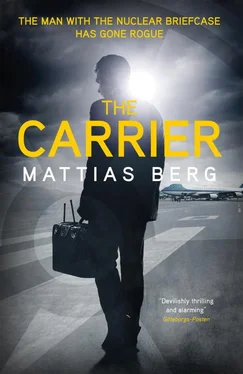Mattias Berg - The Carrier
Здесь есть возможность читать онлайн «Mattias Berg - The Carrier» весь текст электронной книги совершенно бесплатно (целиком полную версию без сокращений). В некоторых случаях можно слушать аудио, скачать через торрент в формате fb2 и присутствует краткое содержание. Город: London, Год выпуска: 2019, ISBN: 2019, Издательство: MacLehose Press, Жанр: Триллер, на английском языке. Описание произведения, (предисловие) а так же отзывы посетителей доступны на портале библиотеки ЛибКат.
- Название:The Carrier
- Автор:
- Издательство:MacLehose Press
- Жанр:
- Год:2019
- Город:London
- ISBN:978-0-85705-788-4
- Рейтинг книги:4 / 5. Голосов: 1
-
Избранное:Добавить в избранное
- Отзывы:
-
Ваша оценка:
- 80
- 1
- 2
- 3
- 4
- 5
The Carrier: краткое содержание, описание и аннотация
Предлагаем к чтению аннотацию, описание, краткое содержание или предисловие (зависит от того, что написал сам автор книги «The Carrier»). Если вы не нашли необходимую информацию о книге — напишите в комментариях, мы постараемся отыскать её.
The Carrier — читать онлайн бесплатно полную книгу (весь текст) целиком
Ниже представлен текст книги, разбитый по страницам. Система сохранения места последней прочитанной страницы, позволяет с удобством читать онлайн бесплатно книгу «The Carrier», без необходимости каждый раз заново искать на чём Вы остановились. Поставьте закладку, и сможете в любой момент перейти на страницу, на которой закончили чтение.
Интервал:
Закладка:
She looked at her wrist-watch—and turned to me for the first time since we had arrived at the olive grove.
“You wouldn’t like to call Aina again, my treasure?”
I took out the cell phone, saw that I had five missed calls from her number. Called my own number, let the engaged tone ring for a certain length of time.
“No answer and no voicemail,” I said.
“Then it probably wasn’t anything important, my treasure.”
When eventually the sun fell on the olive grove she took the last of Jesús María’s preparations out of her own combat pack. The final remnant of that woman’s jet-black humor. Without a word I put on the full beard, the curly black wig and the torn brown shift made of homespun cloth. Realized what she was trying to get at—even though I knew that from the outside I would look no different from all the other martyrs around the perimeter of the base.
It was my mother who told me the whole story, long before I was old enough to understand the detail. She always emphasized that she had been thinking of Erasmus of Rotterdam when deciding on my name, the great European humanist, the symbol for an entirely new world: he who disputed the issue of free will with Martin Luther. But she also told me the colorful story of St Erasmus, who had been born in 240 and died in 303, one of the many victims of the Emperor Diocletian’s persecution of Christians. And it was my mother who first told me that the saint’s symbol was a windlass and that he was martyred by having his intestines slowly wound up on one. As time went on I became almost obsessed with the grim fate of the saint. And Jesús María had put his symbol onto my outfit, elegantly but discreetly. On the lower part of my top, level with my intestines, there was a small windlass embroidered in blood-red thread against the brown of the fabric.
Ingrid scrutinized me, my look yet again entirely new, as if she were trying to get to the bottom of something. I had to look away. At that she put on her own simple outfit, on top of her general combat gear. It looked exactly the same as in Belgium: a white nightshirt cut off above the knees so as not to inhibit movement, blond wig, crown of light in her hair which she would cast off before we went in. Allowed ourselves to be washed along in the big wave of activists, before moving off on our mission once inside the gates.
I could see almost thirty more Lucias along the base’s perimeter fence, without even having to pick up my field glasses. In all probability the most common of all the ensembles being worn by the activists. So there was little risk that anybody would connect Ingrid to the incident inside Kleine Brogel, that inexplicable electrical fault, the sudden smoke at the base.
According to legend, St Lucia came from Syracuse—a hundred miles to the south-east from here, and died just one year after Saint Erasmus. After her torture, Lucia ended up as a prostitute in a brothel. In due course she too, according to the typically convoluted myth, had both boiling oil poured over her and a sword pierce her throat, surviving both. Only when somebody nevertheless gave her the last rites, was she able to be at peace and leave this mortal coil.
Ingrid picked up what looked like a normal lighter and lit the candles before placing the crown on her head, although it was hard to see the flames in the bright sunlight. There was a slight smell of crude rubber or oil. The candles did not blow out even when the wind gusted in the olive grove. They were probably made with some special agent, some chemical witch’s brew.
Then she led us out from the treeline, traversing the slope down toward the installations. None of the security guards who had mingled with the activists made any move to obstruct our way as we took our place by the sign which said “MARTYRS FOR PEACE”.
The crowd grew by the minute. Normal people, those who were curious, family members, full-blown idealists who had taken the day off from their jobs in the village or perhaps didn’t have one in this depopulated area. Global peace activists from far away, with well-worn routines from scores of similar demonstrations. Thanks to the costumes it was as hard as ever to distinguish the professionals from the amateurs. Streamers with the “No M.U.O.S.” message were hanging on the fence surrounding the establishment, like strings of white glue binding it all together, while none of the guards made any move, vastly outnumbered as they were. Gradually the activists inched forward. The mass’ slow landslide.
I then heard a dull roar, first thinking that it must be thunder from some distance away, the normal climax of a scirocco. I looked up at the clear-blue sky—and saw that it was filled with drones from Sigonella.
After that the all-terrain buses arrived, together with the airborne convoy. The Marine One helicopter was escorted by about ten others from the H.M.X.1 squadron in Quantico, Virginia. The special forces troops streamed out of the buses, made straight for the gates, where they lined up in full readiness. The dark bellowing of thousands of soldiers with their adrenaline pumping, even before anything had started to happen. The lighter yelling from the protesters, by now surely closer to three hundred thousand.
Through the field glasses I saw the doors of Marine One opening and our new Secretary of Defense step out. If it really was him—and not just a double. Dropped into the ceremony to mark how important the installations were, the entire M.U.O.S. system, while the real Secretary stayed in Washington to plan our strategy for responding to the developing crisis in Crimea.
He had a Carrier at his side. A dummy, for the sake of appearances, as was the briefcase in the Carrier’s hand. The apparatus which, according to Ingrid, would now have lost all meaning as it was decoupled from the system.
Then came another dull sound from all around us, of people rather than machines. The enormous mass divided, like the Red Sea, while a small figure in a devil’s mask made his way slowly but determinedly toward the gates.
“Blu,” Ingrid said.
I watched his progress: a Messiah being urged on by people thumping him enthusiastically on the back, lifting him up through the crowds. Even twelve-year-old Unity knew about him, had talked about his work. How he made his breakthrough in the suburbs of Bologna and had then wandered all over the world like a ghost. Never more than one mural, or exhibition, at a time in any one place. Identity unknown, computer not connected to the internet, all the necessary measures taken to avoid being traced. His face always in different masks.
Yet he had painted two murals specifically here in Niscemi, in the same place, for the first time in his career. Once Blu had arrived at—or rather been led all the way to—the main gate, he turned around and shouted something which I could not hear. At that, a long line of women wearing black dresses and shawls started moving. They too were allowed to make their way through the crowds to the front line of activists. There they spread out along the wide expanse of the circle. Silence fell over the scene, a sort of collective gathering of breath.
Ingrid checked her watch and I did the same: time 12.51, temperature 96.4 degrees in the burning sun. The sweat was already itching under my clothes. She turned her eyes to me, still in her magical burning crown of light, with that look.
“Now it starts, St Erasmus,” she said, with expectation in her voice.
As if we were at the movies. Or watching a classical tragedy.
6.12
It began with Blu climbing to the very top of the fence. Securing himself with his feet and starting to wave his arms. He was a master at parkour, a seasoned urban explorer, accustomed to finding his way in everywhere to access the perfect painting surface. Through my field glasses I observed the soldiers studying him, their bodies tensed and ready, trying to decide whether he was holding any form of weapon. But in the end they just let him sit there and wave in his devil mask: a bad strategic decision.
Читать дальшеИнтервал:
Закладка:
Похожие книги на «The Carrier»
Представляем Вашему вниманию похожие книги на «The Carrier» списком для выбора. Мы отобрали схожую по названию и смыслу литературу в надежде предоставить читателям больше вариантов отыскать новые, интересные, ещё непрочитанные произведения.
Обсуждение, отзывы о книге «The Carrier» и просто собственные мнения читателей. Оставьте ваши комментарии, напишите, что Вы думаете о произведении, его смысле или главных героях. Укажите что конкретно понравилось, а что нет, и почему Вы так считаете.












